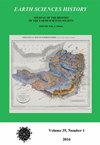1800 年以来新矿物发现率变化的一些特点和原因
IF 0.6
4区 哲学
Q4 GEOSCIENCES, MULTIDISCIPLINARY
引用次数: 0
摘要
地球矿物发现曲线的构建表明,新物种的发现和接受率在 20 世纪中叶突然出现拐点。在此之前,新矿物的发现以每年 0.3 种2 的微弱速度加速。自 1950 年以来,接受新矿物的速度平均为每年 1.04 种2 ,因此在 21 世纪的前 20 年中,每年接受的新矿物超过 100 种。尽管发现的速度如此之快,但 1950 年之前和之后发现的矿物在镍-斯特伦兹分类系统 10 个矿物类别中的相对分布却几乎完全相同。分部、科和矿物组的证实率的变化显示出明显的差异,在较高分类级别中矿物的最大发现率出现在 1950 年之前,而新确认的矿物组的证实曲线与矿物种类的鉴定曲线密切相关。将任何分级分类系统应用于矿物物种都具有一定的随意性,并且会受到与分类系统学相关的偏差或不一致的影响。因此,新矿物的发现也要从数学定义的晶体学空间群对称性的角度来考虑。空间群证明曲线的形状与镍-斯特伦兹系统中较高分类级别的曲线相似。然而,并非所有空间群都有天然矿物。在新矿物发现率出现拐点之前和之后发现的矿物显示出明显不同的成因模式。几乎所有的物种都与 57 种不同的成因模式中的一种或多种有关。与新近发现的矿物相比,早已为人所知的矿物往往具有更多的副成因模式,因此从 1950 年到 2022 年,副成因模式的平均数量呈线性下降趋势。此外,国际矿物学协会(International Mineralogical Association)已将目前公认的矿物种类中 80% 以上的已知最早出现时间制成表格。对于 1950 年拐点之前发现的矿种,最早出现的年龄呈线性分布,表明这些矿物的最早出现年龄均匀分布在 0 至 4700 Ma 的区间内。相反,1950 年后发现的矿物中约有 70% 的已知最早出现年龄小于 600 Ma,这些 1950 年后发现的矿物的年龄分布呈指数分布,表明在构造活跃的环境中发现新矿物的努力在不断增加。尽管 1950 年前和 1950 年后的最古老年龄分布存在差异,但这两个族群在新矿物形成率方面表现出相似的时间偏移,这可能反映了负责新矿物形成的地球系统过程发生了重大变化。本文章由计算机程序翻译,如有差异,请以英文原文为准。
SOME CHARACTERISTICS AND CAUSES OF CHANGES IN THE RATE OF DISCOVERY OF NEW MINERALS SINCE 1800
Construction of a discovery curve for Earth's minerals illustrates an abrupt inflection in rates of discovery and acceptance of new species that occurred in the middle of the 20th century. Prior to that time new mineral discovery is found to have accelerated at a modest pace of 0.3 species / year2. Since 1950 the rate of acceptance has accelerated at an average of 1.04 species / year2 such that the first two decades of the 21st century have been characterized by the acceptance of over 100 new minerals per year. Despite this rapid acceleration of discovery, the relative distribution among the 10 mineral classes of the Nickel-Strunz classification system of minerals identified prior to and after 1950 are nearly identical. Variation in the rates of attestation of the divisions, families, and mineral groups show distinct differences in that the maximum rates of discovery of minerals populating higher taxonomic levels occurred prior to 1950 while the attestation curve of newly recognized groups closely follows that defined by the identification of mineral species. The application of any hierarchical classification system to the mineral species is somewhat arbitrary and subject to biases or inconsistencies associated with the systematics of classification. Therefore, the discovery of new minerals is also considered within the context of the mathematically defined crystallographic space group symmetries. The space group attestation curve has a shape similar to those exhibited by the higher taxonomic levels within the Nickel-Strunz system. However, not all space groups are represented by naturally occurring minerals. Minerals discovered before and after the inflection in rates of new mineral discovery illustrate significantly different patterns of paragenesis. Nearly all of the species have been associated with one or more of 57 distinct paragenetic modes. Minerals that have long been known tend to have a higher number of paragenetic modes than those more recently discovered such that the average number of paragenetic modes is shown to have decreased linearly from 1950 to 2022. Further, the earliest known occurrence of over 80% of the currently accepted mineral species has been tabulated by the International Mineralogical Association. For species discovered prior to the inflection of 1950 a linear distribution of oldest ages is observed indicating that these minerals have earliest ages of occurrence that are uniformly distributed across the interval 0 to 4700 Ma. Conversely, approximately 70% of the species identified since 1950 have oldest known occurrences of less than 600 Ma and the age distribution of these post-1950 minerals exhibit an exponential distribution suggesting increasing efforts in new mineral discovery in tectonically active settings. Despite the differences in the pre- and post-1950 oldest age distributions, both populations exhibit similar temporal excursions in rates of new mineral creation that likely reflect substantial changes in Earth system processes responsible for new mineral formation.
求助全文
通过发布文献求助,成功后即可免费获取论文全文。
去求助
来源期刊

Earth Sciences History
GEOSCIENCES, MULTIDISCIPLINARY-HISTORY & PHILOSOPHY OF SCIENCE
CiteScore
1.00
自引率
0.00%
发文量
1
审稿时长
>12 weeks
期刊介绍:
Earth Sciences History promotes and publishes historical work on all areas of the earth sciences – including geology, geography, geophysics, oceanography, paleontology, meteorology, and climatology.
The journal honors and encourages a variety of approaches to historical study: biography, history of ideas, social history, and histories of institutions, organizations, and techniques.
Articles are peer reviewed.
 求助内容:
求助内容: 应助结果提醒方式:
应助结果提醒方式:


